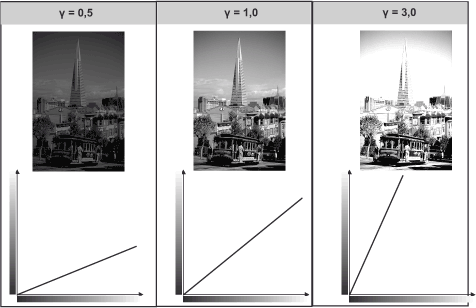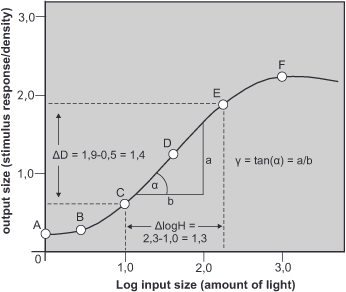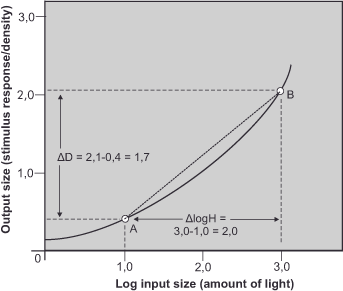You are here: Nature Science Photography – Contrast – Basics
Gamma
The gamma value is the most commonly used measure for assessing the contrast of a characteristic curve. The gamma value serves as a gauge for the linear part of the curve’s slope, revealing the extent of amplified differences. The gamma value is a good measure of developmental negative contrast because the linear part of the curve is most sensitive to developmental changes. Mathematically, the gamma value is defined as the angular function (tangent) of the slope angle between the linear curve portion and the horizontal. Alternatively, we can determine the gamma value as the ratio between two points of the linear part on the x- or y-axis. We determine it by applying the following formula:
Formula 5

ΔD = The density difference between any two points on the linear part of the characteristic curve.
ΔlogH = The logarithmic exposure difference between the two selected points.


In our curve in figure 8, point C is at the lower end of the linear range at 0.5 on the y-axis, and point C is at 1.9. The difference here is 1.9-0.5 = 1.4. On the x-axis, the corresponding values are 1.0 and 2.3. The difference from both values is 2.3-1.0 = 1.3. This results according to the formula:
Formula 6




A slope of 45°, or gamma 1.0, replicates the original brightnesses in a 1:1 gradation, effectively representing a kind of zero position. Gamma values of less than 1.0 result in a flatter curve and less pronounced differences in brightness. Those of more than 1.0 result in a steeper curve with high contrast but cover a smaller brightness range.
Gamma value or gradation are expressions for the amplification of the differences in brightness of the subject in the film: the higher the gamma value, the steeper the gradation, the more pronounced the amplification and the more pronounced the difference between the brightness values in the image and in the original.
Beta value
The beta value gives the average slope angle (SWd) of an imaginary line between two arbitrarily selectable points on the characteristic curve. This is beneficial in situations where the curve contains no or multiple linear segments, making the gamma value ineffective. In addition, the average slope angle is also more practical than the gamma value, because since the two points used to determine it can also be in the sag or shoulder, it leads to a realistic contrast measure. – After all, we don’t solely rely on the linear portion of the curve for exposure!

Thus, two arbitrary points A and B are selected along the characteristic curve as shown in
figure 9, connect them with a straight line, and determine the corresponding density difference on the vertical axis and the exposure difference on the horizontal axis. We then enter both values into a formula that is similar to the gamma value calculation. Depending on how one chooses the points A and B, this method of contrast determination yields different values, so it is important to indicate these alongside the value.
Formula 7

For the example in the figure, the result is as follows:
Formula 8

The slope angle (SWd) of the imaginary line between points A and B (the average slope of the characteristic curve) is therefore 0.85.
Contrast index
The contrast index is a method of contrast determination derived from the average slope angle. Its further development consists in the fact that the curve slope is always indicated over the entire useful range. To achieve this, we place a transparent plastic measuring device over the characteristic curve and shift it to the right or left until the curve intersects the small arc on the left side at the same value as the large arc on the right. This value is the contrast index. However, since measuring devices are hard to come by, one must regularly use a makeshift method: First, choose a point in the sag of the curve that is 0.10 density values above the base density. Then, using the compass, make an arc of radius 2 log exposure levels around this point (pick it off on the horizontal axis). Connect the point in the sag with a straight line to the point where the arc intersects the characteristic curve. The tangent of the slope angle of this line is a good approximation of the contrast index.
Next The dynamic range
Main Contrast
Previous The characteristic curve
If you found this post useful and want to support the continuation of my writing without intrusive advertising, please consider supporting. Your assistance goes towards helping make the content on this website even better. If you’d like to make a one-time ‘tip’ and buy me a coffee, I have a Ko-Fi page. Your support means a lot. Thank you!


 Since I started my first website in the year 2000, I’ve written and published ten books in the German language about photographing the amazing natural wonders of the American West, the details of our visual perception and its photography-related counterparts, and tried to shed some light on the immaterial concepts of quantum and chaos. Now all this material becomes freely accessible on this dedicated English website. I hope many of you find answers and inspiration there. My books are on
Since I started my first website in the year 2000, I’ve written and published ten books in the German language about photographing the amazing natural wonders of the American West, the details of our visual perception and its photography-related counterparts, and tried to shed some light on the immaterial concepts of quantum and chaos. Now all this material becomes freely accessible on this dedicated English website. I hope many of you find answers and inspiration there. My books are on